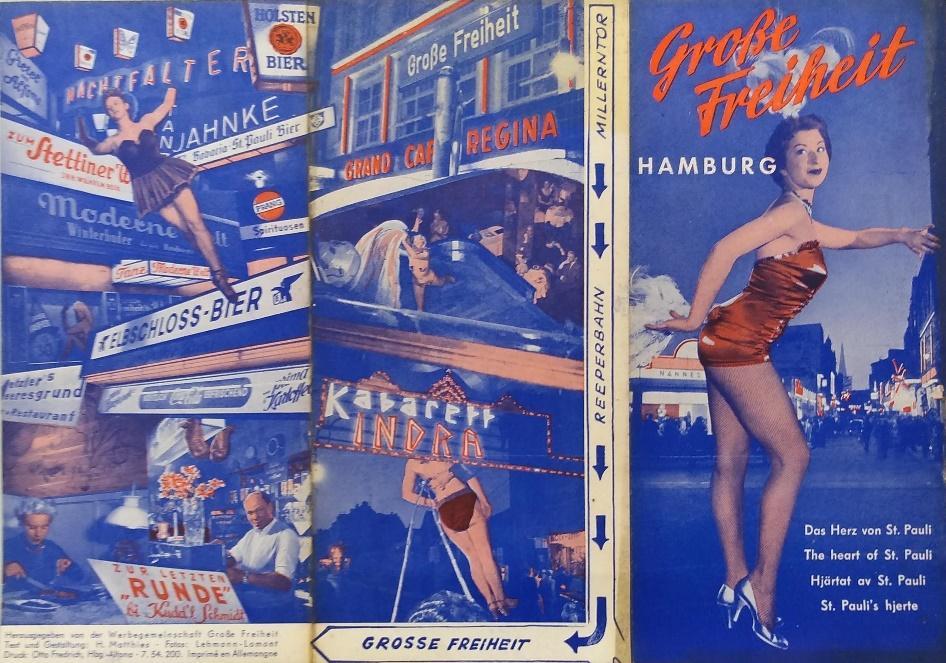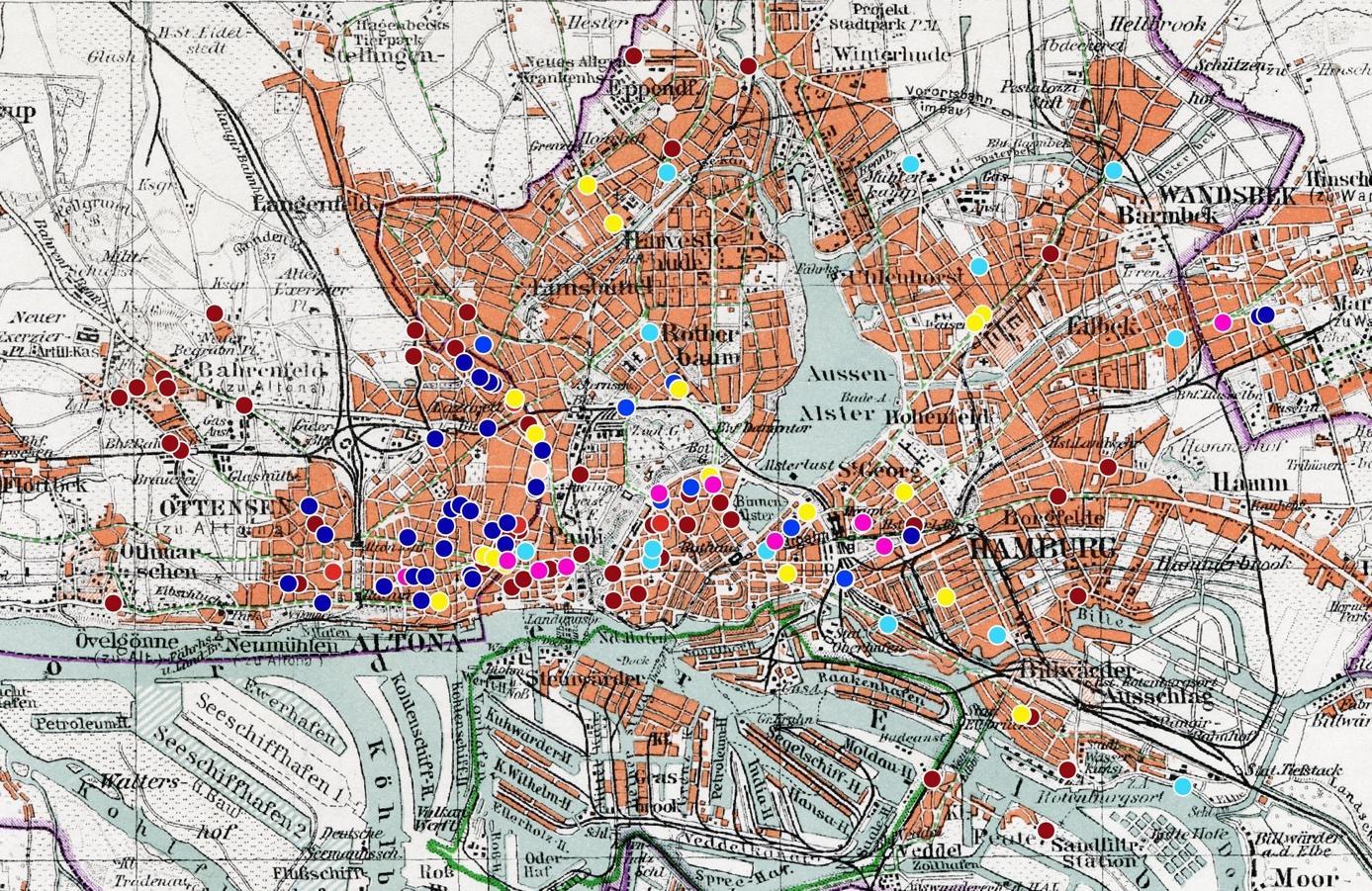Laurenz Gottstein and Alina L. Just
People around the world know Hamburg for its port, but also for its famous entertainment and red light district: the Reeperbahn in the St. Pauli neighborhood. In this blog post, Laurenz Gottstein and Alina L Just, two researchers from the Pleasurescapes-project at HafenCity University Hamburg, explain how they discovered entertainment quarters of the past that mostly fell into oblivion, but are worth revisiting. Through comprehensive mapping of historical address data, they are now able to visualize the spatial hub of the Reeperbahn as it evolved in proximity to the port and its maritime practices, but also next to other port or city-related forgotten entertainment quarters from the early 1900s that are now largely forgotten. They thereby demonstrate that Hamburg’s cityscape of pleasure culture used to be much more diversified.
Happen to be planning a trip to Hamburg? Then you might go to the popular travel magazine Time Out and check out “The 10 best things to do in Hamburg right now”. Ranked at the very top, even before a “Port of Hamburg tour”, you will find the “Reeperbahn Red Light District”. Time Out promotes the place as “Hamburg’s ‘most sinful mile’”, its “erotic playground”, but “also one of the buzziest areas for eating, drinking and live music” (Huw & Beautyman, 2021).“Time Out” is certainly not the only travel guide that recommends the Reeperbahn and St. Pauli as a “must see” of your Hamburg trip. Located near the port, and traditionally a place to make ropes, the Reeperbahn was a go-to place for sailors and visitors alike. Over the last century, travel media have promoted the quarter’s touristic potential and drawn visitors’ attention to it (Amenda, 2009, p. 122). Due to such guides, adverts, but also novels, movies, and popular music (Amenda, 2009, pp. 123-125), the place has grown famous across all countries, ages, and genders.

It is less well-know, however, that in the early 20th century St. Pauli was by far the only place in Hamburg to go out and have fun. Back then plenty of entertainment areas – or “pleasurescapes” as we name them in affiliation with the eponymous research project – existed all over Hamburg, particularly in hubs close to port and train stations. This hidden history of Hamburg entertainment recently emerged in an explorative mapping initiative we conducted as part of the HERA-funded European research project “Pleasurescapes”. Hereby, we present the results and methodology of this mapping, to shed new light on a historical dimension of port city culture, and particularly to broaden the St. Pauli centered narrative of Hamburg’s history of popular culture.
The aim of our mapping was to unveil the distribution and development of Hamburg’s pleasurescapes over time and space comprehensively, with a special focus on the first half of the 20th century. For this purpose, we developed a historical geo-spatial mapping based on statistical historical data. We understand this experiential quantitative approach as a means of research on our way to a more complex qualitative understanding of historical pleasure culture in Hamburg, not as a goal in itself (White, 2010). In doing so, we follow recent claims in research, brought forward by Carola Hein and Yvonne van Mil for instance, that qualitative studies of urban culture need to be linked more closely with quantitative research (Hein and Van Mil, 2019).
Our corpus of data includes entries from the historic address books of not only Hamburg, but also Altona, Harburg and Wandsbek. Although they are all districts of Hamburg today, they were independent cities until 1937. Thanks to the Hamburg State Library, the books are accessible online for the period 1690-1979. We selected books from the years 1910, 1925 and 1935. The address books are organized in several thematic registers, one of them displaying locations of commercial businesses in Hamburg in alphabetical order. We took these commercial registers, extracted sections related to entertainment culture and integrated their address data in equivalent historical maps of Hamburg.
An especially critical part in our endeavor was reflecting the contemporary language for professional entertainment businesses appropriately. This vocabulary was only just emerging in the early 1900s. Many cultural practices might already have existed but have not been officially labeled and registered yet. Others were flourishing back then, but have disappeared today. Prohibited historic businesses of pleasure, such as prostitution, would not appear in the statistical records at all, but will certainly have shaped the topological pleasurescapes severely.
We tried to address all sources of error carefully and applied a rich terminology to our data set. The following categories were taken into account: „Vergnügungslokale“ (entertainment venues), „Clublocale“ / „Gesellschaftshäuser“ (clubhouses / society houses), theatres and cinemas, which were listed in the address book as "theatres of living photographs" in the early years. „Kaffeehäuser“ (coffee houses), „Menageries“ (zoos) and panoramas only partially appear in the address books as separate categories, but were nevertheless included. A particularly difficult category was gastronomy. For one thing, the sheer number of pubs and restaurants was so high that we had to exclude them simply for pragmatic reasons. Besides, we found their social function and topological distribution too broad. Instead, we focused on places of popular entertainment with a performative character. They are unambiguous indicators of pleasurescapes. We understand that all these pleasures went along with drinks and food; there is a fundamental overlap between pleasurescapes and gastronomy. However, for our mapping purpose we relied on the performative entertainment places. As for entities not recorded in the historic books at all, such as prostitution, we admit the lack, but, for the sake of comparable data sets, decided to cope with it instead of integrating additional material. Again, our maps are research tools, not absolute assertions.

We conducted the mapping with QGIS, an open source software frequently recommended for spatial analysis among scholars, also across the humanities (White, 2010; Gregory and Geddes, 2014). The City of Hamburg and HafenCity University Hamburg offer databases with historical maps, which are already digitized and georeferenced, so we could easily import them in QGIS. Especially for the early years, individual sections are missing from these maps or the cartographers ignored the area outside the city limits of the time and only sketched it like a "terra incognita". In these cases, we used similar map materials from other years. We saved the relevant address book entries in an Excel list and placed a point for each entry in our QGIS map. Here we faced another difficult methodological challenge: the historical addresses were not so easy to locate. After we had incorporated the maps of Altona, Wandsbek and Harburg, many streets with identical names appeared, while, during more than a hundred years of city history, some streets and buildings had completely vanished. We turned to the street directory in the address books, which outlines the counting system of the house numbers for each street. Prominent buildings in the street directory and map material helped to find the right locations. In most cases, we were able to identify the exact locations of the entertainment venues. Sometimes, however, we could only estimate a location between two intersections. In general, due to the better source material, the Hamburg locations at the time are more precisely recorded in our map than for Altona, Wandsbek and Harburg.

As a result, we created three interactive maps, which hint at a completely new history of pleasure in Hamburg. Accordingly, St. Pauli has been a place of entertainment for a long time due to the vicinity of the port and presence of sailors, but it was not the only one. In addition, the areas of Neustadt, St. Georg, and the port neighborhoods in the East developed notable pleasurescapes as well. We realize how entertainment structures mirror the different historical stages of urban development: while in the heyday of first urbanization they used to be neighborhood-driven and strongly localized, they were later on merged and concentrated in specific areas, such as St. Pauli or downtown. Today, many of the small but vivid neighborhood pleasurescapes from back then have wholly eclipsed. That is why we designed the published versions of our maps for interactive use, so that everyone can look up which pleasurescapes existed in their neighborhood. We exported our data from QGIS to Tableau Public, a free software for public data visualization. Now, each entertainment category can be activated or hidden separately, and the address, operator and name of the location are displayed in a pop-up field.
All maps are published open access on the “Pleasurescapes”-website, feel free to have a look! And, on your next trip to Hamburg, why not visit the entertainment quarters of the old days and find out how they look today? Our maps will show you where to go!
Acknowledgement
This blog has been written in the context of discussions in the LDE PortCityFutures team. It reflects the evolving thoughts among group members on the socio-spatial and cultural questions surrounding port city relationships. The blog was reviewed and edited by the PortCityFutures editorial team: Carola Hein, Hilde Sennema and Vincent Baptist.
References
Amenda, L. (2009). “Ankerplatz der Freude”. Maritime Bilder und Inszenierungen St. Paulis von den 1890er bis zu den 1960er Jahren. Zeitschrift des Vereins für Hamburgische Geschichte, 95, 111-142.
Geoportal City of Hamburg, https://geoportal-hamburg.de/geo-online/
Gregory, I. N. & Geddes, A. Y. (2014). Introduction: From Historical GIS to Spatial Humanities: Deepening Scholarship and Broadening Technology, in: I. N. Gregory and A. Y. Geddes (Eds.), Toward spatial humanities: Historical GIS and spatial history, Bloomington.
HafenCity University, database for basic geodata, http://gdi-hcu.local.hcuhh.de (access exclusively for HCU staff and students).
Hamburg State Library, http://agora.sub.uni-hamburg.de/subhh-adress/digbib/browsevolume;jsessionid=CB83B9F364F717C36239C1985A6AF2A0.agora12
Hein, C. & van Mil, Y. (2019). Towards a Comparative Spatial Analysis for Port City Regions Based on Historical Geo-spatial Mapping. PORTUSPlus, 8.
Oliver, Huw & Mairi Beautyman, “The 10 best things to do in Hamburg right now”, Tuesday 23 November 2021, https://www.timeout.com/hamburg/things-to-do/best-things-to-do-in-hamburg.
White, R. (2010). What is Spatial History? Spatial History Lab: Working paper. Stanford University, http://web.stanford.edu/group/spatialhistory/cgi-bin/site/pub.php?id=29.
